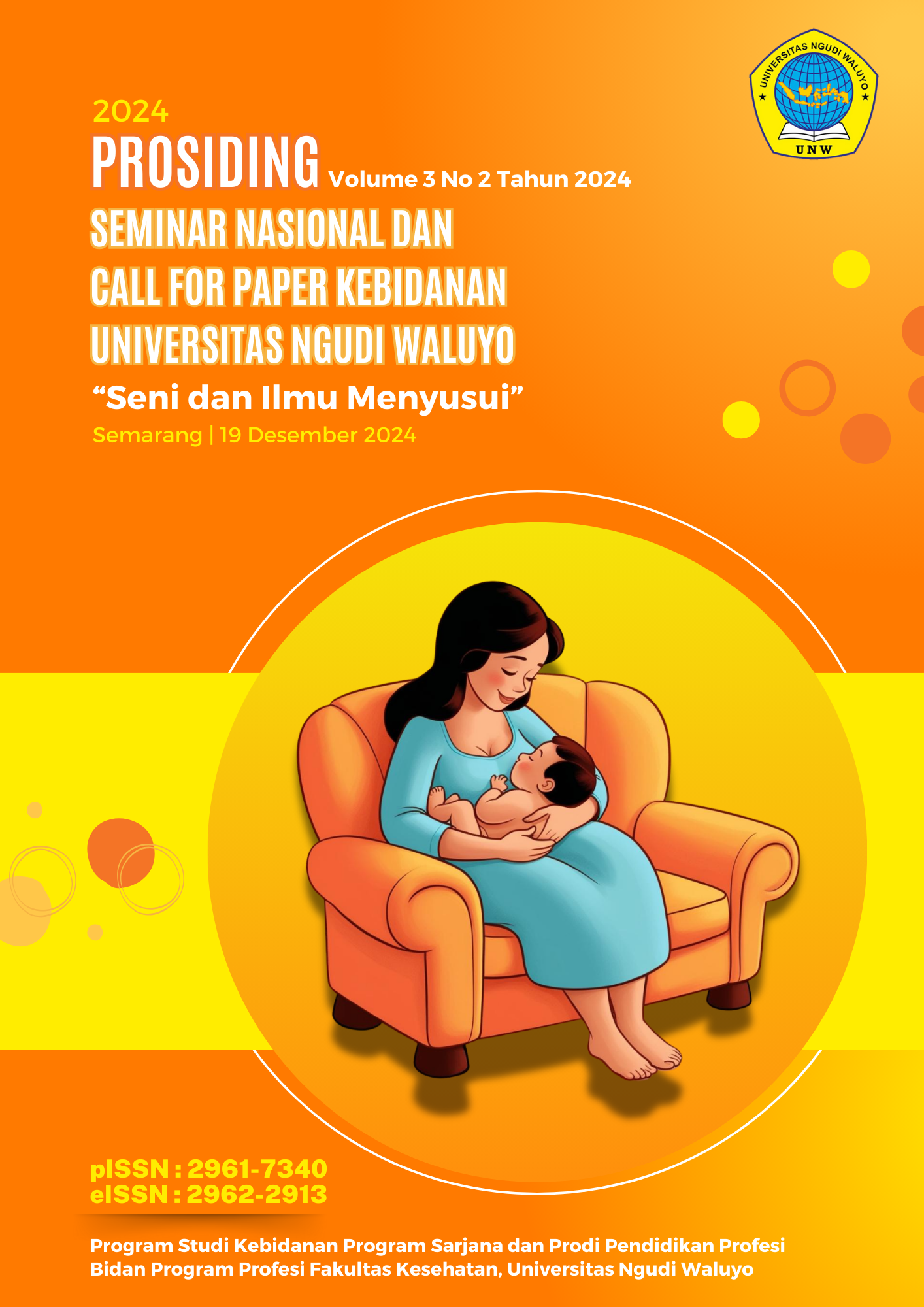Literatur Review Faktor-Faktor yang Mempengaruhi Kejadian Bayi Berat Lahir Rendah (BBLR)
Keywords:
BBLR, bayi baru lahir, Anemia, Kekurangan Gizi, Preeklamsia, Usia IbuAbstract
Low Birth Weight (LBW) is one of the leading causes of neonatal morbidity and mortality worldwide, especially in developing countries. The factors influencing LBW include maternal health, environmental exposure, nutritional status, and access to healthcare services. This study aims to identify the factors associated with LBW through a literature review of six recent studies from the last five years. The method used is a systematic literature search through PubMed, Google Scholar, and ScienceDirect databases using keywords: "Low Birth Weight", "LBW Risk Factors", and "LBW in the last 5 years". The results show that the dominant factors include maternal nutritional status, maternal age, socioeconomic status, pregnancy complications, and smoking habits. Therefore, a multidisciplinary approach is needed to reduce the prevalence of LBW through nutritional improvement, pregnancy monitoring, and health education enhancement.
Abstrak
Bayi Berat Lahir Rendah (BBLR) merupakan salah satu penyebab utama morbiditas dan mortalitas neonatal di seluruh dunia, terutama di negara berkembang. Faktor-faktor yang mempengaruhi kejadian BBLR meliputi faktor maternal, lingkungan, gizi, dan akses pelayanan kesehatan. Penelitian ini bertujuan untuk mengidentifikasi faktor-faktor yang berhubungan dengan kejadian BBLR melalui tinjauan pustaka dari enam studi terbaru dalam lima tahun terakhir. Metode yang digunakan adalah pencarian literatur sistematis melalui database PubMed, Google Scholar, dan ScienceDirect dengan kata kunci: "Bayi Berat Lahir Rendah", "Faktor Risiko BBLR", dan "BBLR dalam 5 tahun terakhir". Hasil menunjukkan bahwa faktor-faktor dominan meliputi status gizi ibu, usia ibu, status sosioekonomi, komplikasi kehamilan, dan kebiasaan merokok. Dengan demikian, diperlukan pendekatan multidisiplin untuk mengurangi prevalensi BBLR melalui perbaikan gizi, pengawasan kehamilan, dan peningkatan edukasi kesehatan.
References
Blencowe, H., Krasevec, J., de Onis, M., et al. (2019). National, regional, and worldwide estimates of low birthweight in 2015, with trends from 2000: A systematic analysis. The Lancet Global Health.
Cunningham, FG (2014). Kebidanan William (Edisi ke-24). Pendidikan McGraw-Hill
Darnarawati, A. T., Rachmawati, D. A., & Hairrudin. (2020). Pengaruh Status Paparan Asap Rokok pada Ibu Hamil sebagai Perokok Pasif dengan Berat Badan Lahir di Puskesmas Arjasa Kabupaten Jember (Effect of Cigarette Smoke Exposure Status on Pregnant Women as Passive Smokers with Birth Weight Events in Arjasa Health. Journal of Agromedicine and Medical Sciences, 6(2), 103–109. https://jurnal.unej.ac.id/index.php/JAMS/article/view/9650/7840
Dewi, H. P., & Mardiana, M. (2021). Faktor Risiko Yang Mempengaruhi Kejadian Anemia Pada Ibu Hamil Di Wilayah Kerja Puskesmas Nusawungu Ii Cilacap. Journal of Nutrition College, 10(4), 285–296.
Dwi Listiarini, U., Maryanti, E., & Sofiah, N. S. (2022). Status Gizi Ibu Hamil Berhubungan dengan Bayi Berat Badan Lahir Rendah (BBLR). Jurnal Kesehatan Mahardika, 9(2), 10–15. https://doi.org/10.54867/jkm.v9i2.107
Faadhilah, A., & Helda, H. (2020). Hubungan Preeklamsia dengan Kejadian BBLR di RSU Kabupaten Tangerang Tahun 2018. Jurnal Epidemiologi Kesehatan Indonesia, 4(1). https://doi.org/10.7454/epidkes.v4i1.3199
Goldenberg, R. L., & Culhane, J. F. (2020). Low birth weight in developing countries. Journal of Maternal-Fetal & Neonatal Medicine.
H. (2023). Pregnancy-Induced Hypertension: Risk Factors And Current Treatment Strategies. Cellular, Molecular and Biomedical Reports, 3(4), 197–204. https://doi.org/10.55705/cmbr.2023.387076.1111
Hapsari, F. N., Astika Gita Ningrum, Muhammad Ardian Cahya Laksana, & Widati Fatmaningrum. (2024). the Correlation Beetween Mother’S Nutritional Status and Parity With the Incident of Low Birth Weight (Lbw) At a Public Health Center Surabaya. Indonesian Midwifery and Health Sciences Journal, 8(1), 38–46. https://doi.org/10.20473/imhsj.v8i1.2024.38-46
Kemenkes RI. 2021. Profil Kesehatan Indonesia Tahun 2020. Jakarta: Kementerian Kesehatan RI
Kementerian Kesehatan RI. (2017). Penilaian Status Gizi.
Kementerian Kesehatan RI. (2018). Epidemi Obesitas.
Khatun, F., Rasheed, S., & Alam, A. (2019). Determinants of low birth weight in developing countries. Public Health Nutrition.
Kumar, C. S., Roy, S., Aishwarya, T., Setty, C. S., Afreen, O., Maheshwari, A., & Ansari,
Koerniawati, R. D. (2022). Jurnal Gizi Kerja dan Produktivitas. Jurnal Gizi Kerja Dan Produktivitas, 3(1), 40–45
Lee, B. K., Park, J., & Shin, S. H. (2020). Effect of maternal smoking on birth outcomes: A meta-analysis. Environmental Health Perspectives.
Maulana, M. I., Mauliza, M., Mardiati, M., Zara, N., & Iqbal, T. Y. (2022). Hubungan Anemia Pada Ibu Hamil Terhadap Kejadian Berat Badan Lahir Rendah Di 2 Rumah Sakit Swasta Kota Lhokseumawe Tahun 2020. AVERROUS: Jurnal Kedokteran Dan Kesehatan Malikussaleh, 8(1), 45. https://doi.org/10.29103/averrous.v8i1.7172
Nahar, S., Rahman, A., & Huque, M. (2021). Maternal anemia and low birth weight. BMC Pregnancy and Childbirth.
Rahmawati, A., Nugroho, F., & Santoso, S. (2020). Relationship between maternal nutritional status and low birth weight. Indonesian Journal of Public Health.
Setiawan, H., Wardani, A., & Sari, D. (2020). Teenage pregnancy and low birth weight. Journal of Health Research.
Supriyatun, S. (2020). Hubungan Status Sosial Ekonomi Dengan Kejadian Bayi Berat Lahir Rendah (Bblr). Jurnal Kesehatan, 8(2), 974–980. https://doi.org/10.38165/jk.v8i2.106
Wibowo, R. P., Prasetyo, B., Fatmaningrum, W., & Modi, A. H. (2022). Correlation Between Early Age Pregnancy with Low Body Weight (LBW) Newborn at Universitas Airlangga Academic Hospital, Surabaya, Indonesia. Biomolecular and Health Science Journal, 5(1), 16–18. https://doi.org/10.20473/bhsj.v5i1.34442
Widianti, E., & Fitriahadi, E. (2023). Anemia Pada Ibu Hamil Sebagai Faktor Risiko Kejadian BBLR. Indonesian Journal of Professional Nursing, 4(1), 6. https://doi.org/10.30587/ijpn.v4i1.5617
Widiastuti, T., Suparman, S., & Handayani, S. (2021). Impact of preeclampsia on neonatal outcomes. Journal of Obstetrics and Gynecology Research.
World Health Organization. (2020). severege in pregnancy. World Health Organization




